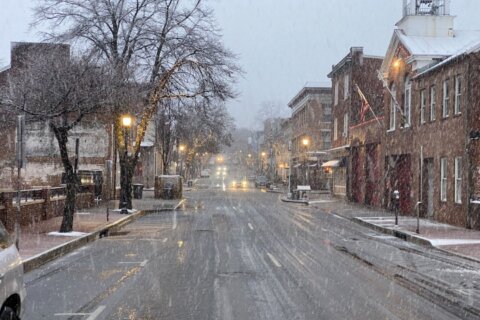Wednesday’s storms produced seven tornadoes across Montgomery County, Maryland, that damaged many homes and trees and injured at least five people.
The National Weather Service issued 22 tornado warnings that day, 7News First Alert Meteorologist Brian van de Graaff said, which is the fourth most in one day since 1986.
Jim Lee, the meteorologist in charge of the National Weather Service’s Baltimore and Washington field office, joined WTOP’s Shawn Anderson and Anne Kramer to discuss the damage caused by the tornadoes and what they mean for the area.
Listen to the interview or read the full transcript below. The transcript below has been lightly edited for clarity.
Shawn Anderson: This feels like the most tornadoes that we have had in Maryland during one specific storm. As you were all tracking the storm and the storm calls on Wednesday, did you get any sense that it was going to be this bad?
Jim Lee: We had a clue starting in the overnight hours on Tuesday night that some of the conditions would be conducive to development. Certainly, you need two things to develop a tornado: you need to have instability in the atmosphere, you also need wind shear. So those two things were coming together. We started putting out messages in our hazardous weather outlook about 4 a.m. on Wednesday morning, saying, essentially, be on the lookout for the possibility of a few tornadoes that day.
Anne Kramer: Jim, I know that a lot of the focus was between Poolesville and Gaithersburg for the tornado that went on for miles. And you all have now actually extended the amount of space and the mileage that it actually covered. Tell us about that.
Jim Lee: Yes, we work closely with our partners at the county and state level, Maryland Office of Homeland Security and the Maryland Department of Emergency Management, as well as our spotter network and public reports. And we get reports and we try to get out and do storm surveys as soon as we can, very often even that same day or that same evening. But we had four teams go out to survey nine possible locations on Thursday. So we had the information that we got in on Wednesday night and early on Thursday morning.
But as the day continues and people start looking at damage in their area, they start sending it in and it just keeps getting bigger and bigger and more reports started coming in. And sure enough, today we were doing additional analysis and we did extend the path length of that Montgomery County storm 26 miles from Dickerson, Maryland, all the way to Ashton, in eastern Montgomery County, so that was quite a long length.
It wasn’t complete damage along that entire path. Very often, in our area, the tornadoes will kind of skip — the funnel cloud will drop down touch the ground, and officially that becomes a tornado, then the tornado will pick up and might go another couple miles and drop down again. So that’s typically what we see in our region. But certainly, a 26-mile path of damage throughout central Montgomery County is quite an extraordinary event.
Shawn Anderson: Historically, Maryland isn’t known for that many confirmed tornadoes like you would see in the Midwest. So has something changed in our atmosphere to maybe cause this? Can we expect these types of storms to continue around here?
Jim Lee: No, I think if you look at the statistics, we average between 10 and 20 tornadoes a year in the region that we forecast for, which includes essentially all of Maryland, west of the Chesapeake Bay, and then down south of Charlottesville. We include Southern Maryland and all the way out to the Appalachian front in the Eastern Panhandle of West Virginia.
We get about 10 or 20 of them. The vast majority of our storms that are tornadoes are what we call EF-0s or EF-1s, which are determined to be minor tornadoes. And that’s not to downplay any of the damage or potential injuries that might happen with an EF-0 or EF-1. But they are not the type of EF-2, moderate to major tornadoes that you’ll see out in the Midwest or Deep South.
Anne Kramer: Is that why we saw so much tree damage, because of the strength of these tornadoes? Is it when you get higher up the scale, is that when you start to see the homes getting lifted or parts of homes coming off?
Jim Lee: Yes, it all depends upon where that funnel cloud touches down. We’re in a nice, forested region for the most part. So most of the damage we see are in the woods and trees around housing developments, that type of thing. But should an EF-1 or EF-0 go through a house, if it’s an EF-0, you might see minor damage, but if it’s an EF-1, you might see some siding offs, shingles, that type of thing.
There was an EF-2 tornado that we did a survey on, probably about 10 years ago down in Stafford County, that demolished the second floor of a home. So yes, as you get up in intensity, it does do more damage to structures, if it just so happens that it comes down, but the areal extent of damage of a tornado is very, very small. And if that funnel though hits the right place, damage can occur and that’s why it’s really important for people to be weather aware of what’s coming at them, and then have an action plan.
Start thinking about it right away, right now. People should be thinking, if you get a severe thunderstorm warning or a tornado warning, get into an interior room of a solid structure, whether it’s a house, a building, whatever. You need to get inside and get away from windows.
Get breaking news and daily headlines delivered to your email inbox by signing up here.
© 2024 WTOP. All Rights Reserved. This website is not intended for users located within the European Economic Area.







